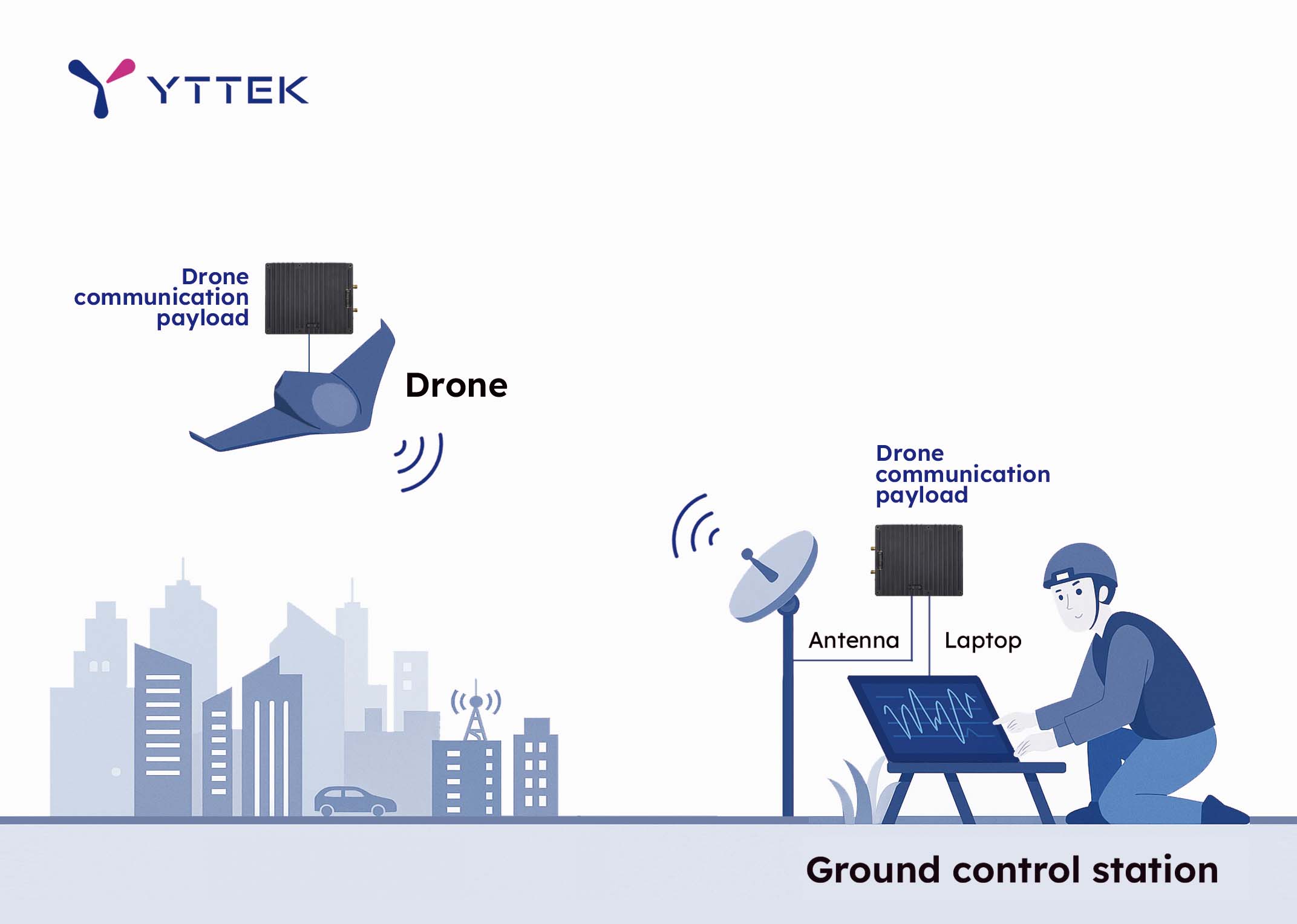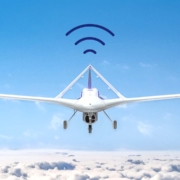What is drone communication? Understand it through 5 key aspects
At the heart of every drone system, drone communication ensures the success of every flight. It enables real-time connectivity between drones and Ground Control Stations(GCS)—powering autonomous flight, long-range data collection, and precise operations.
This article explains the fundamentals of drone communication through five key aspects: system architecture, transmitted data types, communication protocols, modulation techniques, and operating frequency bands.
How drone communication work: from ground to air
At the most fundamental level, drone communication relies on two main nodes working together to maintain control and data flow between air and ground.
- Ground Control Station (GCS): The operator interface that sends flight commands and receives telemetry data.
- Drone-side communication payload: The drone-side communication payload is the onboard SDR drone transceiver that transmits and receives control signals, position data, and live video streams.

YTTEK’s SDRone is a prime example of a drone communication payload, delivering secure, anti-jamming performance and a software-defined, reconfigurable architecture that meets diverse communication needs in mission-critical military-grade drone communication and industrial operations.
Expanding drone communication architecture
Drone communication is no longer limited to the traditional ground-to-air (G2A) link.
As missions grow in scale and complexity, drones now use multiple communication architectures to extend coverage and improve collaboration:
- A2A (Air-to-Air): Enables swarm coordination, formation flying, and cooperative missions between multiple drones.
- A2S (Air-to-Satellite): Connects drones directly to satellite networks for beyond-line-of-sight (BLOS) operations in remote or oceanic regions.
- A2N (Air-to-Network): Integrates drones into terrestrial LTE or 5G networks, including private and secure enterprise deployments.
These architectures expand operational range, resilience, and autonomy—empowering drones to operate seamlessly across dynamic environments.
What data does drone communication transmit?
Understanding what kind of data drones transmit helps illustrate the scope of communication in every flight. Each link carries three primary types of information critical for mission success:
- Command and control (C2): Flight path, take-off and landing instructions, altitude adjustments, and emergency maneuvers.
- Telemetry and monitoring: GPS location, speed, battery level, and system health, providing real-time situational awareness.
- Payload data transmission: High-bandwidth data includes live video, sensor readings, or imagery which relies on a robust high-throughput drone data link to send information from the drone to the ground station.
These combined data streams form the communication backbone that keeps drone operations safe, responsive, and data-driven.
Protocols that power drone communication
Protocols define how drones talk, stream, and coordinate—the rules that ensure reliable and synchronized communication between every node.
- MAVLink: The most common open-source protocol for telemetry and command exchange between the autopilot and the ground control station.
- Lightbridge / OcuSync: Proprietary systems designed to enable reliable control, telemetry, and HD video streaming for commercial drones.
- DSMX / S.Bus: RC-grade (Radio Control) protocols offering low-latency control for hobby and small UAV systems.
- Proprietary and military-grade protocols: Customized links featuring encryption, frequency hopping, and anti-jamming technologies for secure, mission-critical operations.
By using the right communication protocol, drones maintain smooth coordination, clear data exchange, and robust signal integrity across various operational needs.
Modulation techniques: The language of the airwaves
In drone communication, modulation determines how digital data is encoded onto radio waves for transmission. The choice of modulation affects signal stability, range, and data rate — balancing performance across different environments.
- FM (Frequency Modulation): Provides strong noise resistance and stable communication for short- to mid-range links.
- PWM (Pulse Width Modulation): Used for motor and actuator control, offering precise and low-power operation.
- FHSS / DSSS (Spread Spectrum): Improves link security and interference immunity through frequency hopping or wideband spreading.
- OFDM (Orthogonal Frequency Division Multiplexing): Supports high-speed video and data transmission in advanced drone systems.
Operating frequency bands in drone communication
While modulation defines how data travels, frequency bands define where drone communication takes place. Each band serves a unique purpose depending on mission type, range, and operating environment.
- 2.4 GHz / 5.8 GHz ISM bands: Common for consumer and industrial drones, balancing range, bandwidth, and antenna size.
- 900 MHz / 1.3 GHz / L-S-C bands: Commonly used by professional and long-range drone systems for stable, interference-resistant communication and extended operational coverage.
- LTE / 5G frequency bands (700 MHz – 6 GHz): Cellular-based drone communication systems operate within these licensed ranges, enabling beyond-visual-line-of-sight (BVLOS) missions, real-time data streaming, and centralized fleet management.
- Satellite links (Ku/Ka band): Provide global coverage for endurance missions and remote-area operations.
Each frequency band influences transmission performance, link reliability, and spectrum regulation.
YTTEK’s SDRone: aniti-jamming drone communication payload
Designed for mission-critical military and industrial drones with diverse communication requirements, YTTEK’s SDRone Drone Communication Payload delivers advanced anti-jamming performance and exceptional adaptivity. By combining frequency-switching and high-speed frequency hopping within a flexible software-defined radio (SDR) architecture, SDRone becomes the ideal choice for high-demand drone missions that require secure, resilient, and adaptable communication.
Why SDRone is the ideal choice for critical drone communication:
- Anti-jamming: As a premier anti-jamming drone payload, it utilizes frequency switching from 300 MHz to 6 GHz and high-speed hopping at over 2,000 hops per second to ensure stable links even in electronic warfare environments.
- C4ISR-ready: Enables multi-drone coordination, edge computing, and point-to-multipoint (P2MP) communication.
- SWaP-C optimized design: A SWaP-C (Size, Weight, Power, and Cost) optimized drone payload engineered to be compact, lightweight, and power-efficient for seamless drone integration.
- P2MP: Enables a single ground station to control multiple drones simultaneously, enhancing mission coordination efficiency and operational flexibility.
- High data throughput: 32 Mbps throughput enables real-time 4K video streaming and data-intensive autonomous operations.
The adaptive nature of SDRone’s flexible SDR architecture also ensures high reconfigurability to meet evolving communication needs — from industrial applications to military operations.
Ready to elevate your mission resilience? Discover how YTTEK’s SDRone Drone Communication Payload can secure your critical operations. Contact our experts today for detailed specifications and a customized solution.
Lear more about SDRone Drone Communication Paylpoad >>


